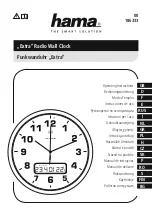
Document Number: pnZXTxRM-0712m
Page
8
Section Two
–
Product Information
2.0 Product Information
2.1 Zlinx
®
Xtreme Radio Modem Models
ZXT9-RM - 900 MHz ISM Band Radio Modem
ZXT24-RM
–
2.4 GHz ISM Band Radio Modem
2.2 Package Contents
Zlinx
®
Xtreme Radio Modem
Software CD
Quick Start Guide
Antenna
Enclosure Mounting Ears and hardware
NOTE: the Cable Glands cannot be used for Class 1 Division 2 applications.
Please see the Quick Start Guide for additional information about UL Class 1
Division 2 installation instructions.
2.3 Modes of Operation
2.3.1 Point-to-Point Serial
This configuration is used to wirelessly transmit serial data from one location to another. A
Zlinx
®
Xtreme Radio Modem is configured with another radio modem of same frequency in
a master slave relationship to transmit serial data wirelessly. Typical applications include
connecting a device such as a pressure/flow transmitter to a PLC or SCADA system.
2.3.2 Point-to-Point Serial to Xtreme I/
O
This configuration is employed to connect a PLC/HMI/SCADA system to a remote Xtreme
I/O or Zlinx I/O module to monitor or control discrete devices via Modbus. The serial
master (PLC/HMI/SCADA) is a Modbus RTU master and must be connected to the serial
port of the Radio Modem. Each Xtreme I/O device populates and updates its own Modbus
map and support Modbus RTU Slave format. The radio modem is connected to the
respective Modbus Master. Typical examples include a Water tank monitoring system
where a float sensor level data is transmitted to a HMI through the wireless network.
2.3.3 Point-to-Multi Point (Serial or Xtreme I/O)
A Radio Modem is configured to communicate with multiple other modems or I/O
modules.
The “master” modem is connected to the Modbus Master and can communicate
with Modbus Slaves connected to other radio modems or Xtreme I/O units. An example is
a PLC Process control/monitoring application requiring analog, digital and serial data to be
brought to a central PLC.
2.4 Operating States
The Zlinx
®
Radio Modem has six operating states.










































